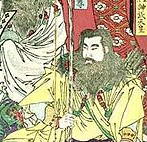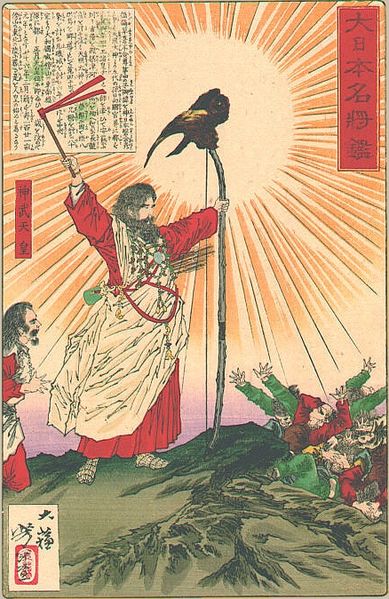<Back to Index>
- Jurist David Dudley Field II, 1805
- Playwright Ion Luca Caragiale, 1852
- Emperor of Japan Jimmu, 711 B.C.
PAGE SPONSOR


Emperor Jimmu (神武天皇 Jinmu-tennō) was the first Emperor of Japan, according to the traditional order of succession. He is also known as Kamuyamato Iwarebiko, his personal names are Wakamikenu no Mikoto or Sano no Mikoto.
The Imperial house of Japan traditionally based its claim to the throne on its descent from Jimmu. No firm dates can be assigned to this early emperor's life or reign, nor for the reigns of his early successors. The reign of Emperor Kimmei (509? - 571 AD), the 29th emperor of Japan according to the traditional order of succession, is the first for which contemporary historiography is able to assign verifiable dates. Modern scholars have come to question the existence of at least the first nine emperors; and Jimmu's descendant, Emperor Sujin is the first many agree might have actually existed. The name Jimmu - tennō was assigned to him posthumously by later generations.
Archaeologists and historians regard Jimmu as mythical or legendary. In Japanese mythology, the Age of the Gods is the period before Jimmu's accession. It is not certain whether he actually existed or if he may have been a composite figure. The conventionally accepted names and dates of the early emperors were not to be confirmed as "traditional" until the reign of Emperor Kammu (737 – 806), the 50th sovereign of the Yamato dynasty.
According to the legendary account in the Kojiki, Emperor Jimmu would have been born on February 13, 711 BC (the first day of the first month of the Chinese calendar), and died, again according to legend, on March 11, 585 BC (both dates according to the lunisolar traditional Japanese calendar).
According to Shinto belief, Jimmu is regarded as a direct descendant of the sun goddess, Amaterasu. Amaterasu had a son called Ame no Oshihomimi no Mikoto and through him a grandson named Ninigi - no - Mikoto. She sent her grandson to the Japanese islands where he eventually married Konohana - Sakuya - hime. Among their three sons was Hikohohodemi no Mikoto, also called Yamasachi - hiko, who married Toyotama - hime. She was the daughter of Ryūjin, the Japanese sea god. They had a single son called Hikonagisa Takeugaya Fukiaezu no Mikoto. The boy was abandoned by his parents at birth and consequently raised by Tamayori - hime, his mother's younger sister. They eventually married and had a total of four sons. The last of these sons, Kamu - Yamato - Iwarebiko, became Emperor Jimmu.
It is said that soon after the beginning of Jimmu's reign, a Master of Ceremonies (saishu) was appointed. This office was commonly held by a member of the Nakatomi clan after the eighth century.
Mythic records in the Kojiki and Nihon Shoki tell us that Jimmu's brothers were originally born in Takachiho, the southern part of Kyūshū (in modern day Miyazaki prefecture), and decided to move eastward, as they found their location inappropriate for reigning over the entire country. Jimmu's older brother Itsuse no Mikoto originally led the migration, and they moved eastward through the Seto Inland Sea with the assistance of local chieftain Sao Netsuhiko. As they reached Naniwa (modern day Ōsaka), they encountered another local chieftain, Nagasunehiko (lit. the long - legged man"), and Itsuse was killed in the ensuing battle. Jimmu realized that they had been defeated because they battled eastward against the Sun, so he decided to land on the east side of Kii Peninsula and battle westward. They reached Kumano, and with the guidance of a three - legged bird, Yatagarasu (lit. eight - span crow), moved to Yamato. There they once again battled Nagasunehiko and were victorious.
In Yamato, Nigihayahi no Mikoto, who also claims to be a descendant of the Takamagahara gods, was protected by Nagasunehiko. However, when Nigihayahi met Jimmu, he accepted Jimmu's legitimacy. At this point, Jimmu is believed to have acceded to the throne of Japan.
According to the Kojiki, Jimmu died when he was 126. This emperor's posthumous name literally means "divine might" or "god - warrior". It is undisputed that this identification is Chinese in form and Buddhist in implication, which suggests that the name must have been regularized centuries after the lifetime ascribed to Jimmu, possibly during the time in which legends about the origins of the Yamato dynasty were compiled as the chronicles known today as the Kojiki.
The actual site of this emperor's grave is not known. This emperor's kami is venerated at a memorial Shinto shrine (misasagi) at Kashihara in Nara prefecture. This mausoleum shrine is formally named Unebi-yama no ushitora no sumi no misasagi.
New Year's Day in the Japanese lunisolar calendar was traditionally celebrated as the regnal day of Emperor Jimmu. In 1872, the Meiji government proclaimed February 11, 660 BC, in the Gregorian calendar the foundation day of Japan, which was then commemorated as the holiday Kigensetsu ("Era Day") until 1948. Suspended after World War II, the celebration was reinstated in 1966 as the national holiday Kenkoku Kinen no hi ("National Foundation Day").
For the Kigensetsu celebration of 1940, according to the calculation the 2,600th anniversary of Emperor Jimmu, the Shōwa regime constructed on the legendary site of Emperor Jimmu's palace, near Miyazaki, the Hakkō Tower. The building was named after the ancient phrase of Hakkō ichiu (literally "eight cords, one roof"), which had been attributed to Emperor Jimmu and since 1928 had been espoused by the Imperial government as an expression of Japanese expansionism, as it envisioned to the unification of the world (the "eight corners of the world") under the Emperor's "sacred rule", a goal that was considered imperative to all Japan subjects, as Jimmu, finding five races in Japan, had made them all as "brothers of one family." This propaganda narrative was officially abandoned at the end of Pacific War when the Japanese government accepted the 1945 Potsdam Declaration. Because of the association with Hakkō ichiu, the Kigensetsu celebration of 1940 is today considered controversial.